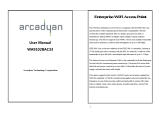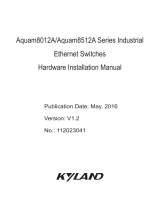
20
Installation BAT-F
Release
17
12/2019
Note for the use in the USA and in Canada
The following section applies to BAT-F variants with the characteristic
value US (USA/Canada) for country approvals which are labeled as
follows:
Contains Transmitter Module
FCC ID: U99EWLAN2
IC: 4019A-EWLAN2
This equipment complies with FCC and IC RSS-102 radiation exposure
limits set forth for an uncontrolled environment. This equipment should be
installed and operated with minimum distance of 19.7 in (50 cm) (related
to a 18 dBi antenna) between the radiation source and your body.
The antenna used for this transmitter must not be co-located with any
other transmitters within a host device, except in accordance with FCC
multi-transmitter product procedures.
This transmitter is restricted to indoor use only within the
5.15 to 5.25 GHz band to reduce potential for harmful interference to co-
channel mobile satellite systems.
This Class B digital apparatus complies with Canadian ICES-003.
Cet appareil numérique de la classe B est conforme à la norme NMB-003
du Canada.
To reduce potential radio interference to other users, the antenna type
and its gain should be so chosen that the equivalent isotropically radiated
power (EIRP) is not more than that permitted for successful
communication.
This device has been designed to operate with the antennas listed below
having a maximum gain of 18 dBi:
Antenna(s) for operation with this
device:
Permitted band of operation
2.4 GHz band 5.15 GHz ...
5.25 GHz band
5.725 GHz ...
5.825 GHz band
BAT-ANT-RSMA-2AGN-R
a
a. Note: When using 3 antennas type BAT-ANT-RSMA-2AGN-R, you must align each antenna
in another spatial direction (x-y-z) so that one antenna is arranged vertically to the device
and the other two antennas are arranged at right angles to each other.
Yes Yes Yes
BAT-ANT-N-3AGN-IP67 Yes Yes Yes
BAT-ANT-N-MiMoDB-5N-IP65 Yes Yes Yes
BAT-ANT-N-MiMo5-9N-IP65 No Yes Yes
BAT-ANT-N-8G-DS-IP65 Yes No No
BAT-ANT-N-MiMo-18N-IP65
b
b. Note: Connect the BAT-ANT-N-MiMo-18N-IP65 to the WLAN module as follows:
Connect the antenna port "Ver" with the WLAN-antenna-port 1.
Connect the antenna port "+45 °" with the WLAN antenna port 2.
Connect the antenna port "-45 °" with the WLAN antenna port 3.
Connect the BAT-ANT-N-MiMo-18N-IP65 antenna in this way exclusively.
Differing connection configurations are illegal.
No No Yes






















